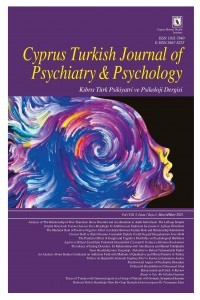Klinik Olmayan Popülasyonda Mükemmeliyetçilik Boyutlarının Sosyal Anksiyeteyle İlişkisi
Mükemmelliyetçilik, Mükemmelliyetçilik Boyutları, Sosyal Aknsiyete
The Relationship of Dimensions of Perfectionism with Social Anxiety in Non-Clinical Population
Perfectionism, Perfectionism Dimensions, Social Anxiety,
___
- Antony, M. M., Purdon, C. L., Huta, V., & Swinson, R. P. (1998). Dimensions of perfectionism across the anxiety disorders. Behaviour Research and Therapy, 36(12), 1143–1154.
- Ashbaugh, A., Antony, M. M., Liss, A., Summerfeldt, L. J., McCabe, R. E., & Swinson, R. P. (2007). Changes in perfectionism following cognitive-behavioral treatment for social phobia. Depression and Anxiety, 24(3), 169–177.
- Barlow, D. H. (1994). Comorbidity in social phobia: Implications for cognitive-behavioral treatment. Bulletin of the Menninger Clinic, 58(2, Suppl A), A43–A57.
- Brown, E. J., Heimberg, R. G., Frost, R. O., Makris, G. S., Juster, H. R., & Leung, A. W. (1999). Relationship of perfectionism to affect, expectations, attributions and performance in the classroom. Journal of Social and Clinical Psychology, 18(1), 98–120.
- Burns, D. D. (1980). The perfectionist’s script for self-defeat. Psychology today, 14(6), 34-52.
- Clark, D. M., & Wells, A. (1995). A cognitive model of social phobia. In R. G. Heimberg, M. R. Liebowitz, D. A. Hope, & F. R. Schneier (Eds.), Social phobia: Diagnosis, assessment, and treatment (pp. 69–93). The Guilford Press.
- Frost, R. O., Marten, P., Lahart, C., & Rosenblate, R. (1990). The dimensions of perfectionism. Cognitive Therapy and Research, 14(5), 449–468.
- Flett, G. L., & Hewitt, P. L. (2014). Perfectionism and perfectionistic self-presentation in social anxiety: Implications for assessment and treatment. In S. G. Hofmann & P. M. DiBartolo (Eds.), Social anxiety: Clinical, developmental, and social perspectives (p. 159–187). Elsevier Academic Press.
- Heimberg, R. G., Horner, K. J., Juster, H. R., Safren, S. A., Brown, E. J., Schneier, F. R., & Liebowitz, M. R. (1999). Psychometric properties of the Liebowitz Social Anxiety Scale. Psychological Medicine, 29(1), 199–212.
- Heimberg, R. G., Liebowitz, M. R., Hope, D. A., & Schneier, F. R. (Eds.). (1995). Social phobia: Diagnosis, assessment, and treatment. The Guilford Press.
- Hewitt, P. L., & Flett, G. L. (1991). Perfectionism in the self and social contexts: Conceptualization, assessment, and association with psychopathology. Journal of Personality and Social Psychology, 60(3), 456–470.
- Hope, D. A., Heimberg, R. G., & Juster, H. A. (2004). Managing social anxiety: A cognitive behavioral therapy approach client workbook. Graywind Publications.
- Juster, H. R., Heimberg, R. G., Frost, R. O., & Holt, C. S. (1996). Social phobia and perfectionism. Personality and Individual Differences, 21(3), 403–410.
- Kawamura, K. Y., Hunt, S. L., Frost, R. O., & DiBartolo, P. M. (2001). Perfectionism, anxiety, and depression: Are the relationships independent? Cognitive Therapy and Research, 25(3), 291–301.
- Kessler, R. C., McGonagle, K. A., Zhao, S., Nelson, C. B., Hughes, M., Eshleman, S., Wittchen, H.-U., & Kendler, K. S. (1994). Lifetime and 12-month prevalence of DSM-III—R psychiatric disorders in the United States: Results from the National Comorbidity Study. Archives of General Psychiatry, 51(1), 8–19.
- Lepine, J. P., & Pelissolo, A. (1996). Comorbidity and social phobia: clinical and epidemiological issues. International clinical psychopharmacology, 11, 35-41.
- Liebowitz, M. R. (1987). Social phobia. Modern Problems of Pharmacopsychiatry, 22, 141– 173.
- Lundh, L.-G., & Öst, L.-G. (2001). Attentional bias, self-consciousness and perfectionism in social phobia before and after cognitive-behaviour therapy. Scandinavian Journal of Behaviour Therapy, 30(1), 4–16.
- Mısırlı-Taşdemir, Ö., & Özbay, Y. (2003). Üstün Yetenekli Çocuklarda, Mükemmeliyetçilik, Sınav Kaygısı, Benlik Saygısı, Kontrol Odağı, Öz Yeterlilik ve Problem Çözme Becerileri Arasındaki İlişkinin İncelenmesi. Yayınlanmamış yüksek lisans tezi, Karadeniz Teknik Üniversitesi, Sosyal Bilimler Enstitüsü, Trabzon.
- Montejo, J., & Liebowitz, M. R. (1994). Social phobia: Anxiety disorder comorbidity. Bulletin of the Menninger Clinic, 58(2, Suppl A), A21–A42.
- Pacht, A. R. (1984). Reflections on perfection. American Psychologist, 39(4), 386–390.
- Rapee, R. M., & Heimberg, R. G. (1997). A cognitive-behavioral model of anxiety in social phobia. Behaviour Research and Therapy, 35(8), 741–756.
- Rosser, S., Issakidis, C., & Peters, L. (2003). Perfectionism and social phobia: Relationship between the constructs and impact on cognitive behavior therapy. Cognitive Therapy and Research, 27(2), 143–151.
- Saboonchi, F., Lundh, L. G., & Öst, L. G. (1999). Perfectionism and self-consciousness in social phobia and panic disorder with agoraphobia. Behaviour research and therapy, 37(9), 799-808.
- Shafran, R., Cooper, Z., & Fairburn, C. G. (2002). Clinical perfectionism: A cognitive behavioural analysis. Behaviour Research and Therapy, 40(7), 773–791.
- Soykan, Ç., Özgüven, H. D., & Gençöz, T. (2003). Liebowitz social anxiety scale: the Turkish version. Psychological reports, 93(3_suppl), 1059-1069.
- Stein, M. B. (1999). Coming face-to-face with social phobia. American Family Physician, 60(8), 2244.
- Stöber, J., & Joormann, J. (2001). Worry, procrastination, and perfectionism: Differentiating amount of worry, pathological worry, anxiety, and depression. Cognitive Therapy and Research, 25(1), 49–60.
- ISSN: 1302-7840
- Yayın Aralığı: Yılda 4 Sayı
- Başlangıç: 2000
- Yayıncı: Kıbrıs Ruh Sağlığı Enstitüsü
Kırsal Kesimde Yaşayan Gebelerin Kaygı Düzeylerinin Belirlenmesi
Sözsüz İvedi Yakınlık Ölçeği- Öz Bildirim Fromunun Türkçeye Uyarlanması
Kimlik Krizi ve Kişilik Bozuklukları: Otantikliğin Aracı Rolü
Klinik Olmayan Popülasyonda Mükemmeliyetçilik Boyutlarının Sosyal Anksiyeteyle İlişkisi
İNTİHAR OLGUSUNDA PSİKOLOJİK ÖZELLİKLERİN İNCELENMESİ
Merve KELEŞ, Elif YÖYEN, Fatih BAL
Afranur ÖZGÖNÜL, Zekeriya Deniz AKTAN, İpek ÜLKÜMEN
Bibliyoterapi Eğitiminin Sosyal-Duygusal Beceriler İle Okuma İlgisi ve Okuma Motivasyonuna Etkisi
Şengül BAŞARI, Ahmet GÜNEYLİ, Gözde LATİFOĞLU YILTAŞ, Gül KAHVECİ
